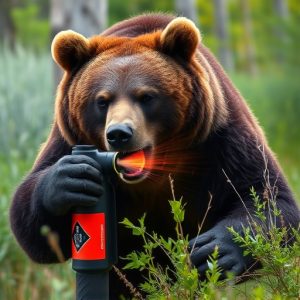Bear Spray: Wilderness Protection or Restricted Weapon?
Bear spray, a non-lethal deterrent made from capsicum, is not classified as a restricted weapon desp…….
Bear spray, a non-lethal deterrent made from capsicum, is not classified as a restricted weapon despite misconceptions. Its proper usage—including timing, distance, and technique—is crucial for effectiveness against bears in wilderness areas. Understanding local laws regarding Is Bear Spray Restricted Weapon is key to ensuring safety and responsible preservation of bear habitats. Effective application involves targeting the bear's face and eyes, but users should be aware of limitations and follow safety precautions, such as keeping it out of children's reach and regularly inspecting the device.
“In remote wilderness areas, encountering bears is an ever-present risk. Here, we explore bear spray—a potent defense mechanism designed to deter aggressive encounters. This article delves into the functionality of bear spray as a wilderness protection device, dissecting its legal status and whether it’s classified as a restricted weapon. We’ll also guide you through effective use and safety precautions, ensuring your outdoor adventures remain safe from these majestic yet potentially dangerous creatures.”
- Understanding Bear Spray: A Wilderness Protection Device
- Legal Status and Regulations: Is Bear Spray Classified as a Weapon?
- Effective Use and Safety Precautions for Bear Spray
Understanding Bear Spray: A Wilderness Protection Device
Bear spray, also known as bear repellent, is a specialized aerosol designed for personal protection against bears in wild environments. It’s more than just a defense mechanism; it’s a crucial tool for outdoor enthusiasts navigating bear country. This innovative device uses capsicum, a compound similar to chili peppers, to create a painful and temporary yet effective deterrent when used correctly.
Contrary to some beliefs, bear spray is not considered a restricted weapon. It’s designed to be non-lethal, intended to incapacitate or deter an attacking bear without causing severe harm. The key lies in understanding its proper usage. Timing, distance, and the right application technique are vital for maximum effectiveness. In areas where bears roam freely, carrying bear spray is often mandatory, ensuring individuals can protect themselves during unexpected encounters.
Legal Status and Regulations: Is Bear Spray Classified as a Weapon?
Bear spray is a controversial topic when it comes to wilderness protection and legal status. While it serves as an effective deterrent against bear attacks, its classification as a weapon remains a point of debate. In many regions, bear spray is regulated as a less-lethal self-defense tool, distinct from firearms or other deadly weapons. This classification allows for its possession and use by hikers, campers, and wildlife managers, who rely on it to protect themselves in areas with high bear activity.
However, the legal status of bear spray varies across countries and jurisdictions. Some regions strictly regulate its sale and use, treating it as a restricted weapon due to its potential for harm if misused. Others have less stringent rules, acknowledging its vital role in preventing dangerous encounters with bears. Understanding local laws and regulations is crucial for anyone planning outdoor activities in bear country to ensure compliance and promote responsible wilderness protection.
Effective Use and Safety Precautions for Bear Spray
Bear spray, while often considered a wilderness protection device, is not a restricted weapon but rather a crucial tool for personal safety in bear-inhabited areas. It’s essential to understand its effective use and safety precautions. When used correctly, bear spray can create a barrier between you and the bear, providing valuable time to escape or seek shelter. The key to success lies in proper application: aim for the bear’s face and eyes, creating a cloud of spray as the animal approaches. This disrupts the bear’s senses, temporarily blinding and disorienting it, allowing you to retreat safely.
Despite its effectiveness, safety precautions are paramount. Always follow instructions provided by manufacturers and local authorities. Keep bear spray readily accessible yet out of children’s reach. Regularly inspect and maintain your spray device, ensuring it’s in working order. Remember, while bear spray can deter aggressive bears, it may not be effective against protective mothers with cubs or extremely hungry or surprised bears. In such cases, immediately seek high ground or a secure shelter.
Bear spray has established itself as an invaluable tool for wilderness protection, offering a non-lethal means of deterring bears. Despite debates over its classification as a weapon, many jurisdictions recognize its importance in bear country. When used correctly and as a last resort, bear spray can significantly reduce the risk of bear attacks. However, it’s crucial to understand local regulations, practice safe handling, and always prioritize prevention through proper wilderness etiquette. By embracing responsible usage, individuals can enhance their safety while enjoying the outdoors and contribute to preserving these valuable ecosystems.


